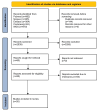Stress fracture risk factors in soccer players: A systematic review
- PMID: 40486656
- PMCID: PMC12140768
- DOI: 10.1097/MS9.0000000000003136
Stress fracture risk factors in soccer players: A systematic review
Abstract
Background: This study conducted a systematic review to evaluate stress fracture risk factors in soccer players, aiming to enhance injury prevention strategies.
Methods: We conducted a systematic review following Preferred Reporting Items for Systematic Reviews and Meta-Analyses guidelines, focusing on professional soccer players. Database searches (Medline, Scopus, CENTRAL, Embase, and Web of Science) used predefined terms in November 2024. Bias assessment employed Joanna Briggs Institute Meta-Analysis of Statistics Assessment and Review Instrument tools, and descriptive synthesis was used due to limited meta-analyzable data.
Results: Our systematic review analyzed 26 studies with 8514 participants. Young age was a risk factor in four studies, and female gender in one. High body mass index, increased training hours, competitions, and intense preseason training also raised risk. Anatomical factors included lower calcaneal pitch angle, wider medial malleolar slip angle, higher Talocalcaneal angle, and lower limb varus malalignment. Stress fractures were higher among midfielders in one study, while two others found no positional differences. Additional risks were elevated parathyroid hormone, higher bone-specific alkaline phosphatase, lower 25OH levels, fasting, and perceived stress from negative life events.
Conclusions: Soccer players face a heightened risk of stress fractures due to the repetitive forces involved in the sport, a significant concern given its global popularity. Although this review identified several risk factors, ongoing controversies remain, primarily due to the limited number of studies and the complex, multifactorial nature of stress fractures.
Keywords: anatomical and physiological predictors; risk factors; soccer players; stress fracture; systematic review.
Copyright © 2025 The Author(s). Published by Wolters Kluwer Health, Inc.
Conflict of interest statement
Sponsorships or competing interests that may be relevant to content are disclosed at the end of this article. The authors declare that they have no competing interests.
Figures





Similar articles
-
Folic acid supplementation and malaria susceptibility and severity among people taking antifolate antimalarial drugs in endemic areas.Cochrane Database Syst Rev. 2022 Feb 1;2(2022):CD014217. doi: 10.1002/14651858.CD014217. Cochrane Database Syst Rev. 2022. PMID: 36321557 Free PMC article.
-
Match Running Performance in Young Soccer Players: A Systematic Review.Sports Med. 2019 Feb;49(2):289-318. doi: 10.1007/s40279-018-01048-8. Sports Med. 2019. PMID: 30671900
-
Ankle Structures of Professional Soccer (Football) Players With Proximal Diaphyseal Stress Fractures of the Fifth Metatarsal.J Foot Ankle Surg. 2019 May;58(3):489-491. doi: 10.1053/j.jfas.2018.09.024. Epub 2019 Feb 11. J Foot Ankle Surg. 2019. PMID: 30765251
-
Stress fractures of the medial malleolus in the professional soccer player demonstrate excellent outcomes when treated with open reduction internal fixation and arthroscopic spur debridement.Knee Surg Sports Traumatol Arthrosc. 2019 Sep;27(9):2884-2889. doi: 10.1007/s00167-019-05483-6. Epub 2019 Mar 26. Knee Surg Sports Traumatol Arthrosc. 2019. PMID: 30915513
-
Increased Risk of ACL Injury for Female but Not Male Soccer Players on Artificial Turf Versus Natural Grass: A Systematic Review and Meta-Analysis.Orthop J Sports Med. 2022 Aug 12;10(8):23259671221114353. doi: 10.1177/23259671221114353. eCollection 2022 Aug. Orthop J Sports Med. 2022. PMID: 35990873 Free PMC article. Review.
References
-
- Iwamoto J, Takeda T. Stress fractures in athletes: review of 196 cases. J Orthop Sci 2003;8:273–78. - PubMed
-
- Matcuk GR, Mahanty SR, Skalski MR, et al. . Stress fractures: pathophysiology, clinical presentation, imaging features, and treatment options. Emerg Radiol 2016;23:365–75. - PubMed
-
- Berger FH, de Jonge MC, Maas M. Stress fractures in the lower extremity: the importance of increasing awareness amongst radiologists. Eur J Radiol 2007;62:16–26. - PubMed
-
- Fredericson M, Jennings F, Beaulieu C, et al. . Stress fractures in athletes. Topics in MR Imaging 2006;17:309–25. - PubMed
Publication types
LinkOut - more resources
Full Text Sources
